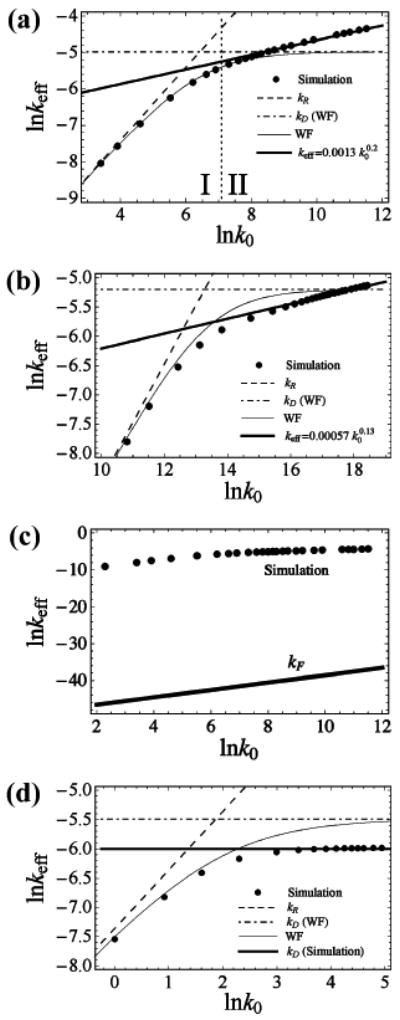Figure 3.

For the exponential quenching model (EQM), the Wilemski–Fixman (WF) theory (eq 3) is qualitatively incorrect in its prediction that the overall quenching rate keff attains a diffusion-controlled limit kD (eq 7) that is independent of the intrinsic quenching rate k0 at large values of k0. In contrast, simulation results exhibit a power-law k0 dependence. At low values of k0, a reaction-controlled limit kR is attained (eq 8), where keff is directly proportional to k0. (a) Various theoretical predictions are compared with simulation data for N = 14 and Rq = 0.2σ, where σ is the polymer bond length. The dotted vertical line provides a rough boundary between regime I (where the WF approximation holds) and regime II (where the kinetics remains exponential and a power law holds). Regime III (where the polymer is effectively frozen) is well outside the range of k0 plotted and occurs at ln k0 ≥ 20. (b) Various theoretical predictions are compared with the simulation data for N = 14 and Rq = 0.091σ, where σ is the polymer bond length. (c) The direct rate kF is many orders of magnitude lower than the actual quenching rate keff determined from simulations (same data as in Figure 3a). Therefore, the onset of the direct quenching mechanism per se cannot explain the deviations from the WF behavior observed in regime II. (d) The WF theory predicts a qualitatively correct behavior of the overall quenching rate keff as a function of the intrinsic quenching rate k0 for CQM, unlike the EQM case. Here, the WF approximation is compared with simulation data for N = 14 and Rq = 21/6σ, where σ is the polymer bond length. The value of Rq chosen here corresponds to the spatial range of the repulsive Lennard-Jones potential acting between monomers. The diffusion limited value kD predicted by the WF theory agrees with the k0 → ∞ limit found from simulations to within a factor of ∼1.7.
